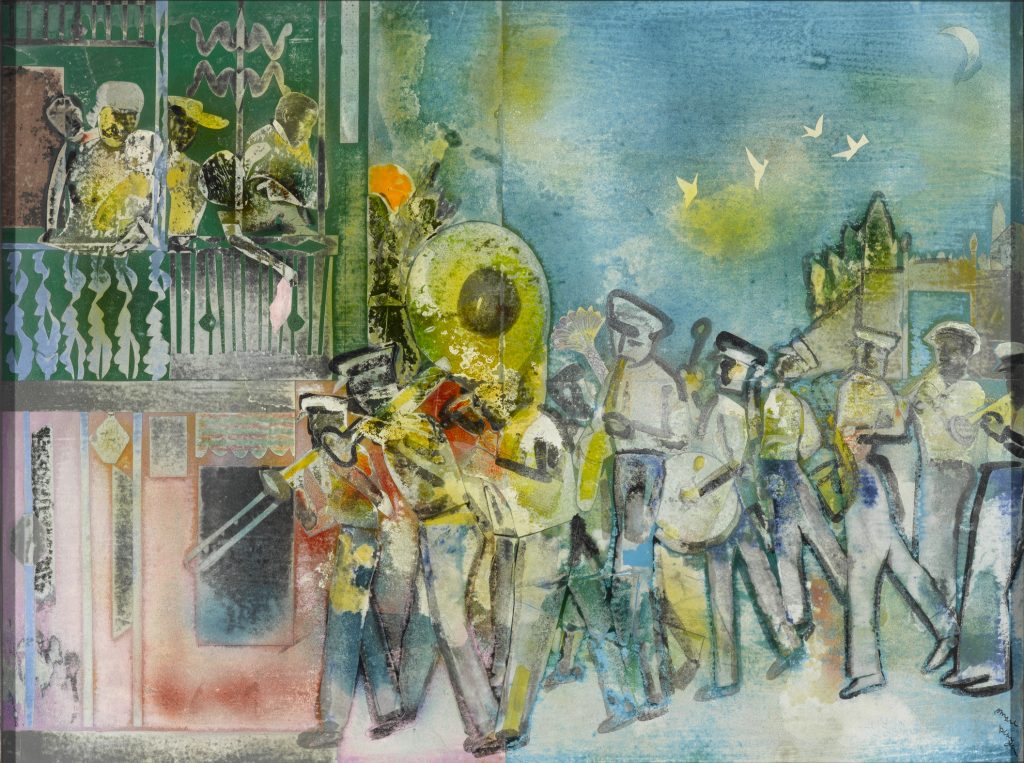The Poetry of Jazz and the Blues with New Orleans: Ragging Home (Quick Tip)
The Poetry of Jazz and the Blues with New Orleans: Ragging Home
By Katherine White, Deputy Director
Romare Bearden’s New Orleans: Ragging Home (1974) is part of a collage series titled Of the Blues, in which Bearden meditates on the evolution of African-American music. Raised in New York during the Harlem Renaissance and heavily influenced by the musicians of the era, Bearden depicts a Black New Orleans Jazz band processing through the streets after a funeral. Bearden uses a variety of shapes (some painted, some cut-out) and colors to bring the New Orleans setting to life, offering a semblance of unity and wholeness amidst an America struggling with civil rights.
Langston Hughes, a prolific voice of the Harlem Renaissance, was likewise influenced by the Blues and Jazz. He was a visitor to Bearden’s childhood home in Harlem. He once described the Blues as “too sad to be funny and too funny to be sad,” songs that contain “laughter and pain, hunger, and heartache.” His body of work at different times captures both this bittersweet description of the Blues and the improvisational nature of Jazz, the art of playing with both spontaneity and conviction, to which Bearden’s collages are often likened.
Poetry Exercise
Introduction
The 1920s brought a decade of cultural creativity in literature, music, and dance, and much of this creativity was centered in Harlem, where music was central to the cultural renaissance and Langston Hughes’s poetry. While the influence of the Blues is most evident in Hughes’s work, his work also embodies the influence of Jazz. Hughes’s Blues poems are most often in stanza form like a typical Blues song whereas his poems that make use of Jazz are typically freer and looser in form, capitalizing on the energy and vitality of the genre.
Langston Hughes published the poem “The Weary Blues” in 1925; this poem mirrors the characteristics of the Blues genre.
Langston Hughes later published the poem “Trumpet Player” in 1947; this poem captures the contrasting exuberance of Jazz.
Activity
Read each poem carefully, making notes about structure. In poetry, structure asks us to examine devices such as rhyme, meter, enjambment, end-stopped line, punctuation, and stanza construction.
- Rhyme: The matching of final vowel or consonant sounds across lines of poetry (or music)
- Meter: The pattern of rhythm in a poem
- Enjambment: A run-on line of poetry (or music) in which logical and grammatical sense carry over from one line to the next
- End-stopped Line: A line of poetry (or music) that ends in punctuation; typically, logical and grammatical sense are concluded at the line’s end.
- Stanza: A division of unit of a poem (or song) that is repeated in the same or a similar form
Read each poem carefully, making notes about the subject of Hughes’s poems. Consider how the subject of each poem mirrors the structure of the poem and its corresponding musical genre.
Additional Resource:
This educator guide from the National Gallery of Art has more insight on the work of Romare Bearden and Langston Hughes.

